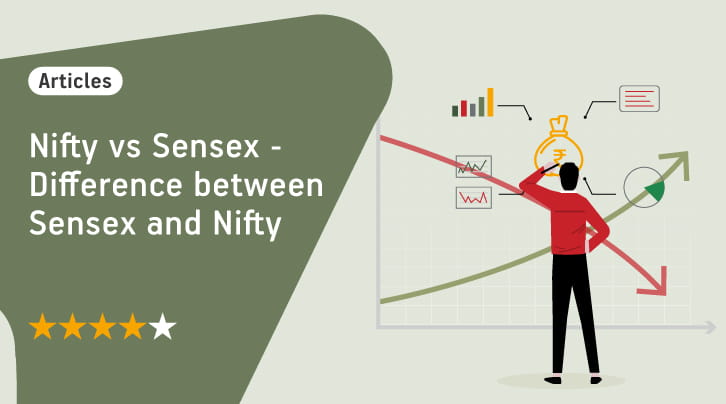Two market indices majorly represent the entire market: Sensex and Nifty. Both act like barometers to gauge the future trajectory of the Indian stock market. Moreover, it measures the alterations within the sector and investors’ portfolios. In this article, learn the difference between Sensex and Nifty with a detailed explanation of what they are. So, let’s start.
What is an Index?
Technically speaking, a stock market index is a cautiously curated collection of businesses traded on the market. These index companies represent a range of economic sectors and industries. Also, companies included in a stock index are often well-established and represent their sector or industry.
Since practically all the key sectors and industries are represented by companies in an index, it is often recognized as one of the finest gauges of an economy’s performance. Besides companies, you can also invest in stock indices via any mutual fund scheme. Let’s now discuss Sensex vs. Nifty, the two most important indices in the nation.
What is Sensex?
Stock market expert Mr Deepak Mohoni came up with the term “Sensex,” which is a combination of the words “sensitive” and “index.” Thirty firms make up the Sensex, and they were selected for inclusion based on the company’s liquidity, market capitalization, revenue, and diversification.
A business must also be listed on the BSE to be included in the Sensex. It serves as a baseline for measuring industrial and economic expansion in India along with the future trajectory of the stock market.
The top 30 stocks make up the Sensex. The index value changes or fluctuates when the price of the underlying securities changes. Whenever the value of Sensex surges, it means the prices of most stocks are also on a surge. The price decline of the majority of the underlying securities is what causes the Index’s value to decline.
What is Nifty?
Nifty is the National Stock Exchange’s (NSE) primary market index. In 1996, it made its debut. The terms “National” and “Fifty” are combined to form the word “Nifty.” Fifty, as it contains the top 50 stocks listed on the NSE, and national, as it is an NSE index.
Normally, the exchange’s free-float market capitalisation comprises 50 stocks, representing 65% of the total. So, when you leverage the Index as a reference, understanding the market performance becomes simpler.
The top fifty blue chip equities listed on the NSE are included in Nifty50. According to the market cap recorded on the exchange, these are the biggest corporations. These stocks, which cover 24 different industries, are the most liquid.
Nifty can be purchased in three different ways: directly through the underlying shares, index funds, or the trading of index-based derivatives. The inclusion of equities in a market index is subject to several requirements. The Index is rebalanced regularly, such as every six months. Depending on the criterion, the Index’s members may change.
Difference Between Sensex & Nifty
Even with our fundamental understanding of Sensex vs. Nifty, there may still be a lot of misconceptions regarding these indices. A stock marketer should be aware of these differences, even if they appear comparable.
Basis |
Sensex |
Nifty |
Abbreviation For |
Sensitive and Index |
National and Fifty |
Base Number |
100 |
1000 |
Base Capital |
NA |
INR 2.06 Trillion |
Base Period |
1978-1979 |
November 3 1995 |
Ownership |
Bombay Stock Exchange |
IISL, NSE Subsidiary |
No. of Sectors |
13 |
24 |
No. of Stocks |
Top 30 companies |
Top 50 companies |
Foreign Exchanges |
Stock Exchanges of BRICS nations & EUREX |
Chicago Mercantile Exchange, Singapore Stock Exchange |
How to Calculate Sensex
One can calculate the Sensex value by considering the base value of the Sensex and the free-float market capitalization of the underlying 30 companies. The steps to determine the value of the Sensex are as follows:
To calculate Sensex, first determine the market capitalization of all the 30 companies listed under it.
Once done, find out the total free float market capitalization
To do so, sum up every other company’s predicted free-float market capitalization.
Sensex = [30 companies’ free float capitalization/Base market capitalization] x Base index value
How to Calculate Nifty
The free float capitalization-weighted technique calculates the Nifty or National Fifty for each of the 50 corporations. Market capitalization is calculated using the share count and the current market price.
The Index’s base market capitalization is the total market value of all of the securities added to the Index during the base period. The market capitalization is converted into an index value of 1000 during the base period, which is referred to as the base index value.
NIFTY Index Value = [Recent Market Value / Base Market Capital] x Base Index Value of NIFTY
Conclusion
Both the Nifty and the Sensex include a few reputable and fundamentally sound corporations. In connection with that, if you invest in one of these indices, you can contribute to the process of wealth development.
So, use a free demat account so that you can invest in the stock market easily and begin the process of capital appreciation.
Mutual Fund investments are subject to market risks, read all scheme related documents carefully.





 1800-270-7000
1800-270-7000




